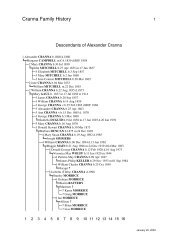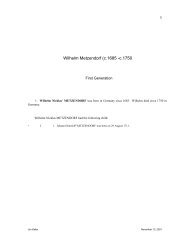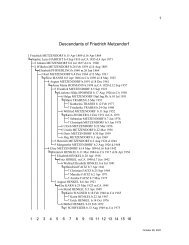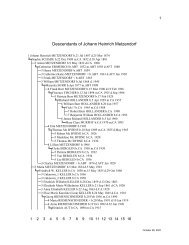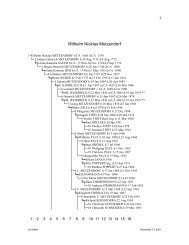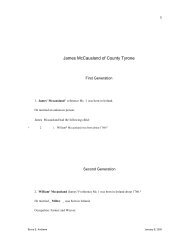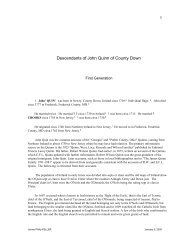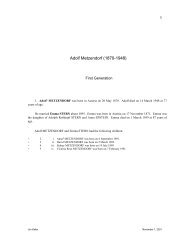A short Account of the <strong>Quinn</strong>, West, Lacy, Pottenger, Kincade <strong>and</strong> Wilson FamiliesE.F.L. <strong>Quinn</strong>died at his house. On his death he willed to him one hundred <strong>and</strong> thirty-five acres adjoining my gr<strong>and</strong>father’s farmon the {page 17} south. James <strong>Quinn</strong> died a year or two after his uncle, I believe in September, 1839, at the age ofabout forty-seven years. I can just recollect him being about four years old at the time of his death. He was a greatfavorite with both his own <strong>and</strong> my father, being of a turn to please almost everybody. He being only two yearsyounger than my father <strong>and</strong> they having worked all of their lives together, they were consequently very muchattached to each other. After his death his family continued for many years to reside on the old home farm, but ithas now been sold <strong>and</strong> is in the h<strong>and</strong>s of strangers. Aunt Sallie <strong>Quinn</strong>, uncle James’ widow, is still living <strong>and</strong>spends part of her time in Winchester, Indiana, with her daughters <strong>and</strong> part of her time in Eaton. My uncle is buriedin the Eaton cemetery.Robert <strong>Quinn</strong>, the fourth child of my gr<strong>and</strong>father, married Sarah Wasson, by whom he had four children. JosephWasson <strong>Quinn</strong>, his oldest son, was born on the 10th day of March, 1823. He has been twice married; first to SelinaHewitt, by whom he had one daughter, Elizabeth <strong>Quinn</strong>, (who married my brother, James Lacey <strong>Quinn</strong>) born in1843, <strong>and</strong> two sons, Calvin Lacey <strong>and</strong> William Harvey. After the death of his first wife, Joseph W. <strong>Quinn</strong> in 1856,married Katherine Waymire <strong>and</strong> by her he had eight children, seven living <strong>and</strong> one dead. He resides in Eaton <strong>and</strong>for the last four years has been coroner of the county. Robert Lacey, the second son of Robert <strong>Quinn</strong>, died young<strong>and</strong> the third son died an infant. Nancy Jane <strong>Quinn</strong> was the fourth child of Robert <strong>Quinn</strong> <strong>and</strong> Sarah Wasson. Afterthe death of her mother she lived first with my father <strong>and</strong> then with her brother. In 1848 she married G. W.Christman <strong>and</strong> in 1854 they removed to Whitley county, Indiana, <strong>and</strong> have since lived in that <strong>and</strong> adjoining counties.She has a large family of children. Robert <strong>Quinn</strong> never remarried after the death of his wife. He is now (February4, 1873) living about four miles northwest of Eaton on the Richmond pike <strong>and</strong> is about 78 years of age.Margaret, the second daughter of my gr<strong>and</strong>father, was married to Peter Aten about the year 1830. By him she hadfive children, two of whom died in, infancy. <strong>The</strong> three children living are named respectively Austin Cunningham,Adrian Robert <strong>and</strong> Aaron P. Austin was born in August, 1832, Adrian in January, 1835, <strong>and</strong> Aaron in June, 1839.Peter Aten resided on the farm west adjoining my father’s in Twin township where he died some time after 1840.After his death the family continued to live there until the fall of the year 1849 when they moved to Peoria county,Illinois.Austin returned in 1853 <strong>and</strong> married Katherine Dunlap, {page 18} a daughter of the man who purchased their farm,<strong>and</strong> took her to Illinois with him. By her he had a large family. <strong>The</strong>y now reside at Abingdon, Knox county,Illinois.Adrian, the second son, lives near Rochester, Peoria county, Illinois. He married a Miss Prats, a sister of EstherHart’s husb<strong>and</strong> <strong>and</strong> has several children.Both Austin <strong>and</strong> Adrian were out during the rebellion in the 77th Illinois Infantry. <strong>The</strong>y were in quite a number ofhard fought battles <strong>and</strong> returned uninjured. Adrian was in a hospital <strong>and</strong> while there his regiment was sent farthersouth. On his recovery he was assigned to a battery <strong>and</strong> participated in Grant’s Chattanooga campaign <strong>and</strong> the battleof Lookout Mountain. He then rejoined his regiment in Louisiana <strong>and</strong> took part in Banks’ Red River expedition.Austin went through the Vicksburg campaign, being engaged in all the battles <strong>and</strong> in the unfortunate assault of the22nd of May, 1863, where so many of our men were slaughtered to no purpose. Both Austin <strong>and</strong> Adrian were at thecapture of Mobile <strong>and</strong> served with their regiment until the close of the war.Aaron, the youngest brother, is now a professor in Abingdon college, Illinois. Aaron has been married twice, first in1860 to Miss Kinkade, a distant relation of my mother, by whom he had one child, a boy, now about 10 years old.She died prior to 1870, <strong>and</strong> in June, 1873, he married Miss Emma Crawford, of Abingdon. Aunt Margaret neverremarried but lives with her children. She has visited Ohio several times.Elizabeth <strong>Quinn</strong>, the third daughter, married Samuel P. Wilson <strong>and</strong> by him had a large family of children, many ofwhom died young. <strong>The</strong> living children are Luther B., Mary, Jane, Katherine <strong>and</strong> Ambrose. <strong>The</strong>y all at this time liveat Muncie, Delaware county, Indiana. Samuel Wilson at the time of his marriage, lived on a farm close to mygr<strong>and</strong>father’s. He then moved to Eaton where he lived up to 1857 or 1858. He owned twenty or twenty-five acresat the east end of town <strong>and</strong> was also engaged in the grocery business.His eldest son, Luther B., was a captain in the 19th Indiana Volunteer Infantry <strong>and</strong> was wounded either at the secondbattle of Bull Run or the battle of Antietam. After the close of the war he was in Washington for several years assecretary to Senator O. P. Morton. He was appointed by President Johnson as Fourth Auditor of the Treasury butfailed of confirmation by the senate. A year or so ago he returned to Muncie, Indiana, <strong>and</strong> is now employed in thebank at that place. He is about forty-two years of age <strong>and</strong> has never married.{page 19} Mary, the oldest living daughter, is about thirty-nine years of age. She was married when she was 17 toJohn W. Burson, at that time teller of the bank at Eaton, <strong>and</strong> about seventeen years her senior. He built the housenow known as the Brooke house on east Main street, adjoining her father’s. <strong>The</strong>y removed from Eaton toCambridge City, Indiana, in 1854 <strong>and</strong> from Cambridge City to Muncie, Indiana, in 1858. His father-in-law <strong>and</strong>family also moved to Muncie. Burson’s one object was to get rich <strong>and</strong> in that he succeeded. He was not miserly butspent freely on his family <strong>and</strong> his friends. When the Democrats carried the Indiana legislature in 1862 <strong>and</strong> refused8
A short Account of the <strong>Quinn</strong>, West, Lacy, Pottenger, Kincade <strong>and</strong> Wilson FamiliesE.F.L. <strong>Quinn</strong>to appropriate money to pay the expenses of the state, Burson organized a syndicate that financed the state for Gov.Morton for two years until the Republicans carried the legislature <strong>and</strong> reimbursed them. On February 10, 1865, heorganized <strong>The</strong> Muncie National Bank with a capital of $50,000. <strong>The</strong> capital was increased to $200,000 on June 1,1865 <strong>and</strong> to $300,000 in 1871. He died in 1872, leaving a fortune estimated at from two hundred <strong>and</strong> fifty to fivehundred thous<strong>and</strong> dollars. He <strong>and</strong> Mary have two children, John Edward <strong>and</strong> Elizabeth, aged (1873) respectivelyabout twenty-one <strong>and</strong> seventeen years. John Edward is in the bank at Muncie, a great portion of which is owned byhis father’s estate. Through Burson, his father-in-law got into the bank <strong>and</strong> managed to make considerable money.Jane, the second daughter, married Charles Moore, an attorney at Muncie. She is now about thirty-seven years ofage <strong>and</strong> has two children.Katherine, the youngest daughter, is unmarried. She is about thirty-four years of age <strong>and</strong> lives with her father <strong>and</strong>mother.Ambrose, the youngest child, is about twenty-eight. He is, I believe, the cashier of the bank at Muncie <strong>and</strong> was marriedlast winter to Miss Hoover, of New Castle, Ind. Both Samuel P. Wilson <strong>and</strong> his wife are still living.Aunt Mary or Polly, my gr<strong>and</strong>father’s youngest child, never married but died on the 29th of September, 1830, whenshe was about twenty-five years of age.My gr<strong>and</strong>father, Robert <strong>Quinn</strong>, died on April 10, 1844, in his 84th year. His widow, Elizabeth Lacey <strong>Quinn</strong>,survived to August 10, 1849. Robert <strong>Quinn</strong> was a farmer all his life <strong>and</strong> was for many years Justice of the Peace forTwin Township. He was very fond of hunting all his life.His eldest son, General John <strong>Quinn</strong>, my father, was born on the 25th day of January, 1790, <strong>and</strong> was consequently inhis sixteenth year when the family moved to Ohio, <strong>and</strong> {page 20} in his eighteenth year when they settled on the farmwhere he spent most of his life.After the close of the war of 1812 my father remained on the farm most of the time until the year of 1830, but duringthis period made two trips to Georgia <strong>and</strong> one to Missouri. <strong>The</strong> first trip was to Georgia <strong>and</strong> I believe, in the year1815 <strong>and</strong> he remained about six months. <strong>The</strong> second trip to that state was made, I believe, in 1824 <strong>and</strong> was with adrove of horses which he <strong>and</strong> others had purchased. He did not make much out of it <strong>and</strong> he never engaged in thatkind of business afterwards. I do not know the date of the trip to Missouri. It was probably shortly before or afterthe last one to Georgia. It was made while his uncle Joseph C. <strong>Quinn</strong> was engaged in lead mining <strong>and</strong> while hiscousin, James K. Lacey, was also living in that state, <strong>and</strong> with the intention of removing there if he liked thecountry. He found Missouri very different from what he had been led to expect <strong>and</strong> returned thoroughly disgustedwith the state. All of these trips were made on horseback, the only mode of traveling at that time.In early life he engaged in distilling with his brother James for a few years, but for the rest of his life he was a strongadvocate of temperance. He was a large man, being six feet <strong>and</strong> one-half inch in height <strong>and</strong> well proportioned. Hewas fine looking <strong>and</strong> when young was very fond of dress <strong>and</strong> a leader of the amusements in the neighborhood. Hewas a fine horseman <strong>and</strong> was very fond of riding. He purchased for his family the first or one of the first carriagesever in Preble county, but for himself he continued even to old age to prefer the saddle.About 1820 he was elected brigadier general of the Ohio militia, which office he filled for several years.Shortly after 1820 he was made a Mason in Bolivar lodge, No. 82, F. & A. M., which had just been established <strong>and</strong>in 1830 he was elected sheriff of Preble county <strong>and</strong> re-elected in 1832.Gen. John <strong>Quinn</strong> was married on July 19, 1831, to Mary Ann Pottenger of Butler county, Ohio. At the time of hismarriage he was in his 43rd year <strong>and</strong> his wife in her 28th.While sheriff my father lived in the sheriff’s residence, a building st<strong>and</strong>ing south of the present 1ocation of the courthouse, the cellar of which constituted the jail, one part of which was partitioned off for the dungeon. <strong>The</strong> prisonerswere of three classes—first, persons accused of crime; second, prisoners for debt; third, insane or idiotic paupers. Iremember as a boy, being taken there by my father (after his term as sheriff had expired) <strong>and</strong> my older brother {page21} <strong>and</strong> I looked down into the dungeon, the trap door being raised. My brother thought he saw a man <strong>and</strong> I supposehe did, as there was one or two in at the time. I saw nothing.Thomas Pottenger <strong>Quinn</strong>, the brother of whom I have just spoken, was born in the sheriff’s residence on July 6,1832.After his retirement from the sheriff’s office my father moved with his family to his father’s farm in Twin township,where he continued to live except during the period he was at Columbus on the board of equalization <strong>and</strong> in the legislature,until he removed to Eaton in 1872. His father deeded him the north half of the farm <strong>and</strong> willed him thesouth half at his death.9
- Page 1 and 2: A Short Account of theQuinn, West,
- Page 3 and 4: A short Account of the Quinn, West,
- Page 5 and 6: A short Account of the Quinn, West,
- Page 7: A short Account of the Quinn, West,
- Page 11 and 12: A short Account of the Quinn, West,
- Page 13 and 14: A short Account of the Quinn, West,
- Page 15: A short Account of the Quinn, West,



